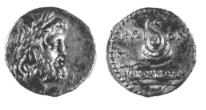Cos, silver, hemidrachms (Asclepius/coiled snake) (201-190 BCE)
From SILVER
201 BCE - 190 BCE Silver 419 kg
Description
| ObverseInscription or printing placed on the obverse.: | Head of Asklepios laureate, right, in circular dotted border. |
| ReverseInscription or printing placed on the reverse.: | KΩΙΟΝ (nos 1-7) ou ΚΩΙΩΝ (nos 8-9) (Greek).Rearing coiled snake with head raised to right, KΩΙ to left of snake's raised forepart, -ON/ΩΝ to right, name below snake, all in a circular dotted border. |
Mint and issuing power
| MintIdentifies the place of manufacture or issue of a numismatic object.: | Cos | Ancient regionAncient region.: | Caria (islands) | Modern countryModern country: Greece | AuthorityIdentifies the issuing power. The authority can be "pretended" when the name or the portrait of X is on the coin but he/she was not the issuing power. It can also be "uncertain" when there is no mention of X on the coin but he/she was the issuing power according to the historical sources: |
Chronology
| FromIdentifies the initial date in a range assigned in a numismatic context. | 201 BCE | toIdentifies the final date in a range assigned in a numismatic context.. | 190 BCE | PeriodTime period of the numismatic object.: Hellenistic 323-30 BC |
Physical description
| MetalThe physical material (usually metal) from which an object is made.: | Silver |
Median weightMedian of the weights of numismatic objects (in grams). in grams | 2.30 | DenominationTerm indicating the value of a numismatic object. Examples: tetradrachm, chalkous, denarius.: | hemidrachm |
StandardStandard.: |
References
| Die study referencePublication of the study: | Höghammar 20071Höghammar 2007, p. 81-82, pl. 16-17 (Issue D). | ||
| Coin series referenceReference to coin series study: | |||
| Coin series web referenceCoin series web references: | |||
Obverse dies distribution
| FrequencyFrequency of specimen in distribution. ᵖ | Number of obversesNumber of obverse dies. ᵖ (o) | % (o) | Number of coinsNumber of coins. (n) | % (n) | Die nameName(s) of the die(s). |
| 1 | 2 | 40 | 2 | 22.22 | 4, 5 |
| 2 | 2 | 40 | 4 | 44.44 | 2, 3 |
| 3 | 1 | 20 | 3 | 33.33 | 1 |
| Total | 5 of 5 | 100 | 9 of 9 | 99.99 |
Reverse dies distribution
no distribution is available
Quantification
| Number of obversesNumber of obverse dies. ᵖ (o) | 5 | Number of singletons (o1)The number of singleton coins. ᵖ | 2 |
| Number of reverse diesNumber of reverse dies. (r) | 7 | Number of coinsNumber of coins. (n) | 9 |
| Coins per obverse dieNumber of coins per obverse die. (n/o) | 1.8 | Coins per reverse dieNumber of coins per reverse die. (n/r) | 1.29 |
| Reverse per obverse ratioRatio of obverse dies divided by reverse dies. (r/o) | 1.4 | Percentage of singletons (o1)number of coins (n) divided by the number of singletons (o1) ᵖ | 40 % |
| Original number of dies (O) (Carter 1983 formula)The estimation of the number of coins according to Carter 1983 ᵖ | 9.11 | Coins struck if 20,000 as average productivity per dieCoins made if the average productivity for obverses (according to Carter) is 20,000. ᵖ | 182,200 |
| Original number of dies (O) (Esty 2011 formula)The estimation of the number of coins according to the singleton formula in Esty 2011 ᵖ (O) | 11.25 | Survival rate if 20,000 as average productivity per dieSurvival rate if average productivity is 20,000. ᵖ | 0.00005 |
| Coverage (o = % of O) (Esty 1984 formula)Esty 1984 - coverage (% of O) ᵖ (o = % of O) | 77.78% | Die productivity if survival rate 1/2,000Average productivity if survival rate is 1/2,000. ᵖ | 1,975.85 |
| Weight of silver (in kg) if 20,000 coins per die (O = Carter formula)Carter 1983 * Median weight * 20000 (*10 if gold or electrum) ᵖ | 419 kg <br /> 419 kg | Die productivity if survival rate 1/5,000Average productivity if survival rate is 1/5,000. ᵖ | 4,939.63 |
Remarks
Most likely one single workstation
References
- ^ Höghammar, Kerstin (2007), "A Group of Koan Issues from c. 200 BC", Numismatic Chronicle 167, p. 81-82, pl. 16-17 (Issue D).
